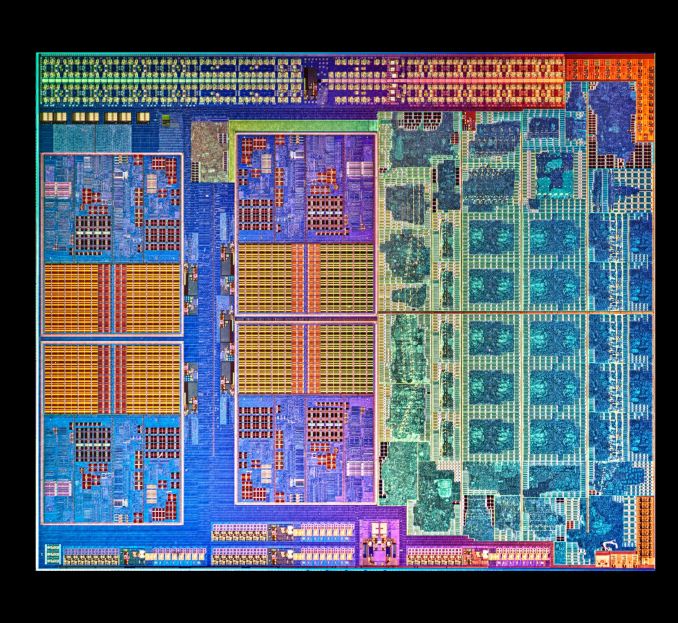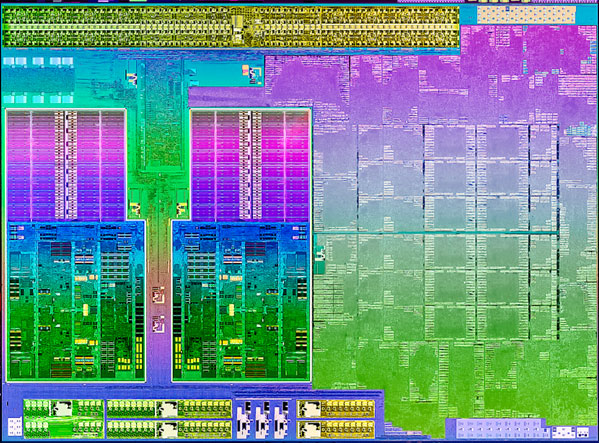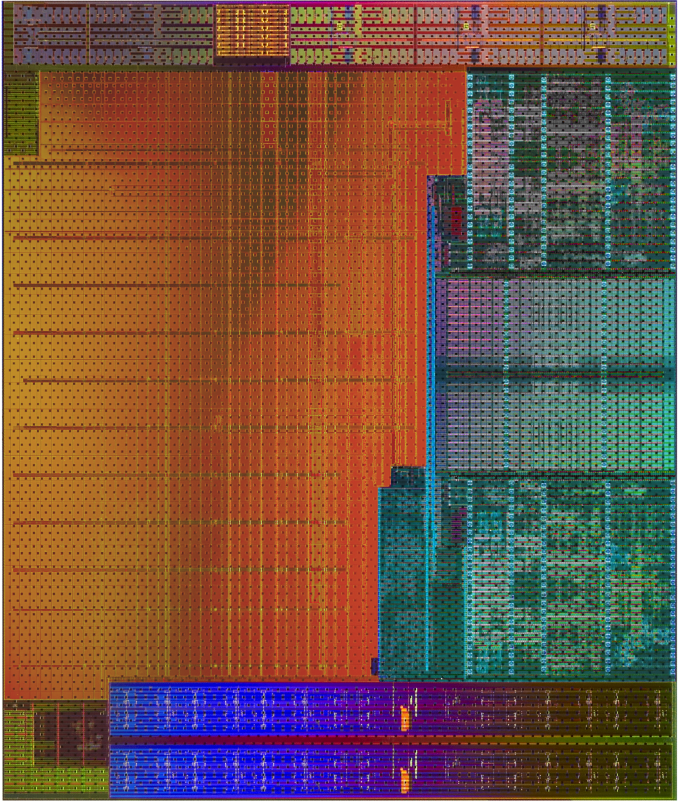AMD Kaveri Review: A8-7600 and A10-7850K Tested
by Ian Cutress & Rahul Garg on January 14, 2014 8:00 AM ESTLlano, Trinity and Kaveri Die: Compared
AMD sent along a high res shot of Kaveri's die. Armed with the same from the previous two generations, we can get a decent idea of the progression of AMD's APUs:
Llano, K10 Quad Core
Trinity and Richland Die, with two Piledriver modules and processor graphics
Kaveri, two modules and processor graphics
Moving from Llano to Trinity, we have the reduction from a fully-fledged quad core system to the dual module layout AMD is keeping with its APU range. Moving from Richland to Kaveri is actually a bigger step than one might imagine:
| AMD APU Details | ||||
| Core Name | Llano | Trinity | Richland | Kaveri |
| Microarch | K10 | Piledriver | Piledriver | Steamroller |
| CPU Example | A8-3850 | A10-5800K | A10-6800K | A10-7850K |
| Threads | 4 | 4 | 4 | 4 |
| Cores | 4 | 2 | 2 | 2 |
| GPU | HD 6550 | HD 7660D | HD 8670D | R7 |
| GPU Arch | VLIW5 | VLIW4 | VLIW4 | GCN 1.1 |
| GPU Cores | 400 | 384 | 384 | 512 |
| Die size / mm2 | 228 | 246 | 246 | 245 |
| Transistors | 1.178 B | 1.303 B | 1.303 B | 2.41 B |
| Power | 100W | 100W | 100W | 95W |
| CPU MHz | 2900 | 3800 | 4100 | 3700 |
| CPU Turbo | N/A | 4200 | 4400 | 4000 |
| L1 Cache |
256KB C$ 256KB D$ |
128KB C$ 64KB D$ |
128KB C$ 64KB D$ |
192KB C$ 64KB D$ |
| L2 Cache | 4 x 1MB | 2 x 2 MB | 2 x 2 MB | 2 x 2 MB |
| Node | 32nm SOI | 32nm SOI | 32nm SOI | 28nm SHP |
| Memory | DDR-1866 | DDR-1866 | DDR-2133 | DDR-2133 |
Looking back at Llano and Trinity/Richland, it's very clear that AMD's APUs on GF's 32nm SOI process had a real issue with transistor density. The table below attempts to put everything in perspective but keep in mind that, outside of Intel, no one does a good job of documenting how they are counting (estimating) transistors. My only hope is AMD's transistor counting methods are consistent across CPU and GPU, although that alone may be wishful thinking:
| Transistor Density Comparison | ||||||||
| Manufacturing Process | Transistor Count | Die Size | Transistors per mm2 | |||||
| AMD Kaveri | GF 28nm SHP | 2.41B | 245 mm2 | 9.837M | ||||
| AMD Richland | GF 32nm SOI | 1.30B | 246 mm2 | 5.285M | ||||
| AMD Llano | GF 32nm SOI | 1.178B | 228 mm2 | 5.166M | ||||
| AMD Bonaire (R7 260X) | TSMC 28nm | 2.08B | 160 mm2 | 13.000M | ||||
| AMD Pitcairn (R7 270/270X) | TSMC 28nm | 2.80B | 212 mm2 | 13.209M | ||||
| AMD Vishera (FX-8350) | GF 32nm SOI | 1.2B | 315 mm2 | 3.810M | ||||
| Intel Haswell 4C (GT2) | Intel 22nm | 1.40B | 177 mm2 | 7.910M | ||||
| NVIDIA GK106 (GTX 660) | TSMC 28nm | 2.54B | 214 mm2 | 11.869M | ||||
If AMD is indeed counting the same way across APUs/GPUs, the move to Kaveri doesn't look all that extreme but rather a good point in between previous APUs and other AMD GCN GPUs. Compared to standalone CPU architectures from AMD, it's clear that the APUs are far more dense thanks to big portions of their die being occupied by a GPU.













380 Comments
View All Comments
srkelley - Wednesday, January 15, 2014 - link
Some of us don't have a lot of money. It may be only $100 but it could mean giving up on buying games just to get a more powerful rig that can't play... games (that you would be willing to buy anyway). I'd like to buy/build a system that's great all around, I'd love to have the very best. The very best is overkill and some systems while not the best are still a bit too pricey.This APU will meet nearly all of my needs and exceed quite a few of them. I'm fine with not being able to max out my settings in every game, I'll be able to max most of them out at 1920x1080 @60 fps (or higher) with this apu. If the improvements in hybrid crossfire pan out (due to decreased latency and improvement in implementation) - I may be able to buy a super cheap gpu at a much later date to cover the rest of what I would need it for. I'll also be able to cool my system for a lower price (or just use stock everything).
Even if cf is a bust, the core product let's me spend a bit more on memory, better storage, a better case and even pick up a few new games without breaking my budget (if I sell my current monitor for asking price, I may be able to use it subsidize a slightly better one at the same time!). Right now I use a netbook, a smart phone and a pc that would struggle to play the original Assassin's Creed at 30fps with a 640x480 screen resolution. The monitor, speakers and wireless keyboard set is the only nice thing about my set-up. Time to step into the future - it's more than good enough for me and people like me.
Dribble - Thursday, January 16, 2014 - link
You can buy a cheaper non-apu cpu and discrete radeon graphics card for about the same amount and that would play games better and do everything else just as well, and still give you all the AMD advantages (mantle, etc). Would also give a better upgrade path as when in the future you are better off you can more easily upgrade cpu or graphics to something faster.The APU only really wins when you need it in a very small box too (so no room for discrete graphics)
Nagorak - Wednesday, January 15, 2014 - link
Well, I will say that one place that this may actually be worthwhile is in an HTPC with a tiny case that can't even take a half height graphics card. With anything that can take a half height graphics card it's moot.mikato - Wednesday, January 15, 2014 - link
But why do you need a discrete card with an HTPC? You don't.rpsgc - Tuesday, January 14, 2014 - link
No gaming benchmarks with dGPU? (I'm not talking about Dual Graphics.) Some people are interested on how this performs purely as a CPU, seeing as AM3 is apparently dead.YuLeven - Tuesday, January 14, 2014 - link
Well, it costs US$173. You can buy a Pentium G + Radeon HD7770GE for US$175~ on Newegg today. One set gives you all-in-one subpar 720p gaming, the other goes as up as 1080p in many titles. In fact, it's nearly cruelty comparing a HD7700GE to Kaveri's GPU.Well, unless you desperately need a one-chip solution, I see Kaveri as being utterly pointless as far gaming is concerned.
Ian Cutress - Tuesday, January 14, 2014 - link
It will be the focus of my next Gaming CPU article update; retesting over a dozen CPUs for this review, at 30 hours each, wasn't an easy task.YuLeven - Wednesday, January 15, 2014 - link
Super, Ian! I can't wait for it.srkelley - Wednesday, January 15, 2014 - link
Thanks for your hard work, you and Rahul did a great job! I always love reading the reviews at Anandtech. They're very informative, easy to read and leave me with a much, much better understanding of whatever they're covering when compared to how I went into it.Drumsticks - Tuesday, January 14, 2014 - link
Any chance you can make a summary of the 65 and 45W APUs vs an i3-4330 at 54W? That would be a more apt comparison especially considering the price range.